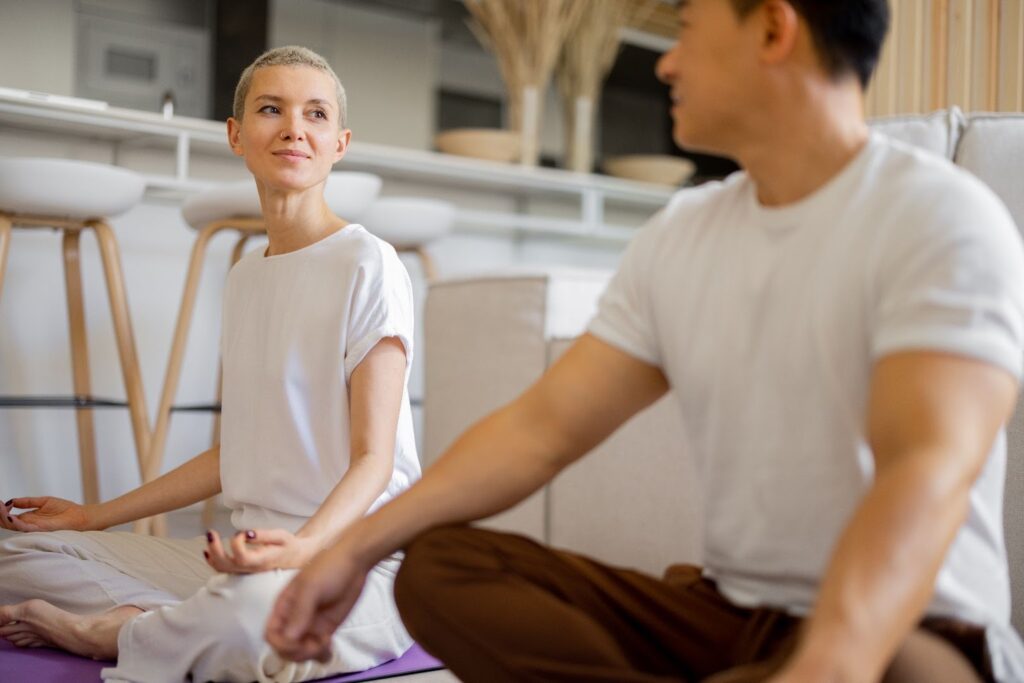Mindfulness and meditation are less about adding one more task and more about changing the way you meet each moment. By training attention to return—again and again—to breath, body, and what’s actually happening, you reduce noise and reclaim energy. Over time, you respond instead of react, choose rather than drift, and notice calm where rush used to be. The benefits are not mystical; they’re practical: steadier focus, softer stress cycles, clearer priorities, and relationships that feel more spacious. A balanced life isn’t the absence of challenge; it’s the capacity to stay grounded while challenges move through.
How Mindfulness and Meditation Stabilize Your Nervous System
Your body’s stress response is helpful in emergencies, but exhausting when it never turns off. Gentle breath awareness and nonjudgmental noticing cue the parasympathetic system, the branch responsible for rest and recovery. As breathing slows and lengthens, heart rate steadies and muscles release unnecessary tension. With repetition, your baseline shifts: triggers feel less sticky, and calm becomes easier to access on demand. This physiological reset doesn’t require long retreats; a few minutes of consistent practice can begin teaching your system how to settle.
Mindfulness and Meditation for Emotional Agility
Emotions move in waves. When you meet them with attention instead of argument, they crest and pass more cleanly. Practice gives you language for what you feel and room to choose what to do next, so you waste less energy resisting or ruminating.
Name It To Tame It
Putting feelings into words lowers intensity and clarifies the next wise step.
Expand The Pause
A breath-length gap between impulse and action is enough space to choose better.
Mindfulness and Meditation in Daily Habits, Not Extra Work
The easiest practice is the one that fits a life you already live. Pair attention with activities you do every day—making coffee, showering, church services, waiting at a red light. Let those moments become anchors: feel the cup’s warmth, the water on your shoulders, your hands resting on the wheel. That gentle return turns neutral time into recovery time. You’re not chasing stillness; you’re inviting it into ordinary minutes so balance accumulates without overhauling your schedule.
Improve Focus and Productivity with Mindfulness and Meditation
Distraction fractures deep work. A brief settling ritual—sixty seconds of breath, relaxing your jaw, setting one intention—can prime your brain to concentrate. During work blocks, noticing when attention wanders and gently redirecting it preserves momentum. Over hours and days, this trains cognitive stamina. You spend less time context switching and more time moving the one thing that matters forward.
Single-Task Sprints
Choose one meaningful task, set a short timer, and keep attention tethered until the bell.
Attentional Warmups
Before opening apps, take five slow breaths and name your top priority out loud.
Mindfulness and Meditation for Better Sleep and Recovery
Many people carry daytime speed into bedtime. A wind-down practice—such as a body scan, lengthened exhale, or soft attention on ambient sounds—tells the system it can power down. The goal isn’t to force sleep; it’s to rehearse drowsiness cues so your body recognizes them later. With repetition, you fall asleep faster, wake less often, and start the day with more even energy. Balanced sleep is the foundation every other habit stands on.
Mindfulness and Meditation Within Relationships
Presence is the secret ingredient of trust. When you listen with your whole attention—eyes, posture, breath—people feel it, and conversations soften. In conflict, noticing your own tightening and letting one breath lengthen reduces defensiveness. You don’t abandon your viewpoint; you deliver it with care. Over time, this widens the space for repair and strengthens connection.
Listen To Understand
Reflect back what you heard before responding so both nervous systems can relax.
Repair Faster
A brief apology or clarification now prevents a long, avoidable distance later.
Find Purpose With Mindfulness and Meditation
A balanced life is not evenly distributing effort; it’s pointing effort at what matters. Quiet attention clarifies values and reveals the friction of misalignment. As you notice what activities replenish or drain you, decisions become simpler. You say yes more slowly and no more kindly. Purpose stops being an abstract ideal and becomes the pattern of choices that match your values in real time.
Getting Started With Mindfulness and Meditation Habits You Can Keep
Sustainability beats intensity. Start small, link practice to existing routines, and let progress be measurable but forgiving. If you miss a day, you begin again. The point is repetition, not performance, and the results compound—like interest—for steady balance.
Two-Minute Check-Ins
Pause at transitions—before calls, after meals—and take five slow breaths to reset.
Tiny Anchors
Choose a physical cue, like touching a doorknob, to remind you to unclench your jaw and soften your shoulders.
Track What Changes
Note sleep quality, irritability, or focus. Seeing shifts keeps motivation honest.

Avoiding Common Mindfulness and Meditation Pitfalls
It’s easy to turn practice into another way to judge yourself. Perfectionism, comparison, and spiritual bypassing can creep in and erode balance. A kinder stance works better: meet the mind you have today, not the one you wish you had. If sitting feels impossible, walk slowly and feel your feet. If thoughts are loud, focus on the sound of your breath. Curiosity makes practice resilient.
Consistency Over Intensity
Short daily sessions outlast rare marathons and build more durable benefits.
Curiosity Beats Judgment
Noticing with interest keeps learning alive when progress feels uneven.
Choosing Teachers for Mindfulness and Meditation
Good guidance accelerates learning. Seek teachers and resources that emphasize safety, agency, and ethics. Apps and local classes can provide structure; books and talks can deepen understanding. Pay attention to results in your actual life: calmer mornings, easier focus, kinder conversations. Tools are useful if they help you live your values with less friction.
Bringing Mindfulness and Meditation Into Your Life
Clarity grows when you make small, value-aligned choices and watch the outcomes. Before saying yes, feel your breath and ask whether the commitment serves your priorities. Before sending a message, read it once with a slow exhale. These micro-pauses won’t remove all stress, but they will reduce avoidable stress. That is the heart of balance: fewer self-made storms and more capacity for real weather.
Visit The Living Church blog to learn more about the importance of mindfulness and meditation in your day-to-day life.



